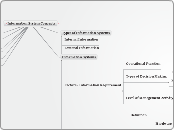Information System Concepts
Types of Information Systems
Internal Information
External Information
Information Systems
Factors - Information Requirement
Operational Function
Types of Decision Making
Programmed Decisions
Non-Programmed Decisions
Level of Management Activity
Strategic Level or Top Level
Tactical level or Middle Level
Operational Level or Supervisory Level
Computer Based Information Systems
Definition
Components
Hardware
Software
Data
Procedures
People
Areas - Computer Based Applications
Finance and Accounting
Marketing and Sales
Manufacturing
Inventory / Stock management
Human Resource Management
Types of Information Systems
Information System Levels
Top Level Management
Strategic Level
Midlle Level Management
Tactical Level
Supervisory Level Management
Operational Data
Information System - Categories
Operation Support Systems
Transaction Processing Systems
Definition and Activities
TPS - Components
Inputs
Processing
Storage
Outputs
TPS - Features
Large Volume of Data
Automation of Basic Operations
Benefits are easily measurable
Sources of Input for Other Systems
Management Information Systems
Definition
Management
Information
Systems
Functions
Determination of Information needs
Data Gathering and Processing
Desimination
Storage
Evaluation Indexing and abstraction
Information Use
Charecteristics - Effective MIS
Management Oriented
Management Directed
Integrated
Common Data Flows
Heavy Planning Component
Sub System Concept
Common Database
Computerized
Misconceptions - MIS
Prerequisites - MIS
Database
Qualified System and Management Staff
Support of Top Management
Control and Maintanance of MIS
Evaluation - MIS
Constraints - Operating an MIS
Effects of using Computers - MIS
Speed of processing and retrieval of data increases
Scope of Analysis widened
Complexity of system design and operation increased
Integrates the working of different Information systems
Increases the effectiveness of Information systems
More Comprehensive Information
Limitations - MIS
Enterprise Resource Planning Systems
Definition
Objectives
Integration of Various Business processes
Business System
Production
Maintanance
Quality Control
Marketing
Finance
Personnel
Consolidation of Business Operations
Myths of ERP System
Charecteristics - ERP System
Flexible
Modular and Open
Integrated
Best Business Practices
Features - ERP System
Benefits - ERP System
Better use of Organizational Resources
Lower Operating Costs
Proactive Decision Making
Decentralized Decision Making
Enhanced Customer Satisfaction
Flexibility in Business Operations
Limitations - ERP System
Management Support Systems
Definition
Types of MSS
Decision Support System
Definition
incl Programmed Decision Systems
Charecteristics
Semi structured and Unstructured Decisions
Flexibility to adapt to changing needs
Ease of Learning and use
Components of DSS
The user
Manager
Staff Specialists (Analysts)
Database
Levels of Implementation
Physical Level
Logical Level
External Level
Planning Languages
General Purpose Planning Languages
Special Purpose Planning Languages
Model Base
Examples - DSS - Accounting
Cost Accounting System
Capital Budgeting System
Budget Variance Analysis System
General Decision Support System
Executive Information System
Definition - EIS
Definition - Executives
Charecteristics - EIS
Executive Roles and Decision Making
Strategic Planning
Tactical Planning
Fire Fighting
Executive Decision Making Environment
Charecteristics of Types of Information used for decision Making
Lack of structure
High Degree of Uncertainity
Future Orientation
Informal Source
Low Level of Detail
Differntiate between EIS and Traditional Information Systems
Contents - EIS
Expert Systems
Definition
Business Applications
Accounting and Finance
Marketing
Manufacturing
Personnel
General Business
Need - Expert Systems
Benifits - Expert Systems
Expert System Development - Potential Qualification
Availability
Complexity
Domain
Expertise
Structure
Components - ESS
Knowledge Base
Inference Engine
Knowledge Accquisitiion Sub - System
User Interface
Office Automation Systems
Definition
Types of Operations
Document Capture
Document Creation
Receipts and Distrubution
Filling, Search, Retrieval and Follow up
Calculations
Recording Utilization of Resources
Benefits - OAS
Building Blocks - OAS
Text Processors and related systems
Electronic Document Management Systems
Electronic Message Communication Systems
Components
Electronic Mail
Features
Electronic Transmissions
Online Development and Editing
Broadcasting and Re-routing
Integration with other Information Systems
Portability
Economical
Fascimile (Fax)
Voice Mail
Teleconferencing and Video Conferencing Systems
Definition
Introduction
Types of system
Classification
Interactive Behavior
Open
Interacts freely with environment
taking Input - Returning Output
Change in environment - Change in system
Influenced by elements outside system Boundary
Information Systems
Closed
Does not Interact with change in Systems
does not change with change in environment
Finally Run down or disorganized
Movement to disorder is is increase in ENTROPY
Quantitative Measure
Disorder in a system
Decay or disordered or disorganized
Negative ENTEROPY - Maintanance
Offsetting increase in entropy
Inputs of Matter and Energy
to repair replenish and maintain system
Elements
Abstract
Conceptual or Model
Ideas about god
Orderly Arrangement
Interdependant Ideas or Constructs
Physical
Tangeable Elements
Circulatory Systems
Operate Together
Transportation System
Accomplish Objective
Weapons System
Display activity/ Behavior
Parts interact to achieve Objective
Degree of Human Intervention
Manual
Carried out by Human Efforts
Data Collection
Maintanance
Final Reporting
Automated
Computers or Microprocessors are used
to carry out all the tasks
Not 100% automated
Reasons - computers
Handling Huge Volumes of Data
Storing Enormous Volume of Data
Quick and accurate processing of Data
Quick Retrieval of information on query
quick - effiecient transportation of Data
Quck decision making - Tools - For decsion making
Working / Output
Deterministic
Predictable Manner
Interaction amongst the parts - Known certainity
Description of - given point plus description
Next state known with certainity
Computer Program according to set of instructions
Probabilistic
Probable Behaviour
Certain Degree of Error attache to what system will do
Average Demand, Average time for replenishment, Instructions given to human
Definition of a System
Orderly Arrangement
Set of Interrelated and Interdependant Elements
Operate Collectively
Accomplish some common purpose or Goal
Human System, Busines system, Computer Based Information System
General Model of a System
Input
Data Flowing
Into System
From Outside
Processing
Manipulating Input
More Useful Form
Storage
Holding information
Use at Later date
Output
Information flowing
Out of the System
Feedback
System Environment
System Definition
System Boundary
Subsystem
Definition
Sub System
Interfaces
Charecteristics-Sub Systems
Decomposition
Simplification
Decoupling
Inventory Buffer - Waiting Lines
Slack and Flexible Resources
Standards
Supra Syatem
Definition
System Stress and System Change
Information
Definition
Attributes of Information
Availablity
Purpose
Mode and Format
Decay
Rate
Frequency
Completeness
Reliability
Validity
Quality
Transperancy
Value of Information
Adequacy
